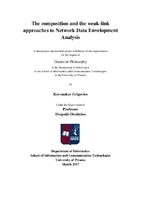The composition and the weak-link approaches to Network Data Envelopment Analysis

Doctoral Thesis
Συγγραφέας
Koronakos, Grigorios
Κορωνάκος, Γρηγόρης Γ.
Ημερομηνία
2017-03Επιβλέπων
Δεσπότης, ΔημήτριοςΠροβολή/
Λέξεις κλειδιά
Data Envelopment Analysis (DEA) ; Composition approach ; Weak-link approach ; Multi-objective programming ; Network DEA ; Περιβάλλουσα Ανάλυση Δεδομένων ; Περιβάλλουσα Ανάλυση Πολυσταδιακών Διεργασιών ; Συνθετική προσέγγιση ; Μέθοδος του αδύναμου κρίκου ; Πολυκριτήριος προγραμματισμόςΠερίληψη
Η συστηματική αποτίμηση της αποδοτικότητας ενός οργανισμού και η οριοθέτηση επιτεύξιμων στόχων αποτελούν συμπληρωματικές θεμελιώδεις πτυχές για την εύρυθμη λειτουργία του και τη βιωσιμότητά του. Συνεπώς, είναι απαραίτητη η υιοθέτηση τεχνικών αξιολόγησης που λαμβάνουν υπόψη όλους τους παράγοντες από το περιβάλλον λειτουργίας του οργανισμού, ώστε να εντοπίζουν τις μη αποδοτικές παραγωγικές διαδικασίες και να προτείνουν επαρκείς τρόπους για την βελτίωσή τους. Μια τέτοια τεχνική είναι η Περιβάλλουσα Ανάλυση Δεδομένων – ΠΑΔ (Data Envelopment Analysis - DEA), η οποία αποτελεί πλέον τη δημοφιλέστερη μη παραμετρική τεχνική για την αποτίμηση της αποδοτικότητας ομοειδών μονάδων ενός συστήματος (μονάδες απόφασης) επί τη βάσει πολλαπλών εισροών και πολλαπλών εκροών.
Οι κλασσικές μεθοδολογίες της ΠΑΔ θεωρούν τις μονάδες απόφασης ως «μαύρα κουτιά» (black boxes) που χρησιμοποιούν εισροές για την παραγωγή εκροών, αγνοώντας την εσωτερική τους δομή. Αυτό έχει ως συνέπεια τα κλασσικά μοντέλα της ΠΑΔ να μπορούν μερικώς μόνο να ανταποκριθούν στην αποτίμηση της αποδοτικότητας όταν η εσωτερική δομή είναι γνωστή και κρίσιμη για τη λειτουργία της μονάδας. Το κενό αυτό έρχεται να καλύψει η Περιβάλλουσα Ανάλυση Πολυσταδιακών Διεργασιών (Network DEA), η οποία αποτελεί πρόσφατη επέκταση της κλασσικής ΠΑΔ. Πρόκειται για μια μεθοδολογία που μπορεί να εφαρμοστεί για την αξιολόγηση μονάδων απόφασης, οι οποίες απαρτίζονται από πολλά μέλη (γνωστά και ως διεργασίες, υπο-διαδικασίες, υπο-μονάδες παραγωγής ή στάδια), διότι λαμβάνει υπόψη την εσωτερική τους δομή και τις σχέσεις αλληλεπίδρασης που τη συνοδεύουν. Η κάθε μονάδα απόφασης (σύστημα) λειτουργεί ως ένα δίκτυο από διατεταγμένες διεργασίες οι οποίες συνδέονται και αλληλεπιδρούν μέσω εσωτερικών ροών υποπροϊόντων (ενδιάμεσων μεγεθών), τα οποία έχουν διττό ρόλο διότι αποτελούν ταυτόχρονα εκροές μιας υπο-διαδικασίας και εισροές μιας άλλης. Ενδεικτικό παράδειγμα αποτελεί η εφοδιαστική αλυσίδα που περιέχει πολλά μέλη και η εύρυθμη ή η μη αποδοτική λειτουργία του κάθε μέλους αντανακλάται στη συνολική λειτουργία της. Συνεπώς, η εκτίμηση της συνολικής αποδοτικότητας της εφοδιαστικής αλυσίδας (συστήματος) πρέπει να γίνεται συντονισμένα λαμβάνοντας υπόψη τις αποδοτικότητες των μελών της.
Στην παρούσα διδακτορική διατριβή διεξάγουμε μια λεπτομερή ανασκόπηση των μεθόδων που έχουν προταθεί στη βιβλιογραφία στο πλαίσιο της Περιβάλλουσας Ανάλυσης Πολυσταδιακών Διεργασιών. Μελετούμε τις ιδιότητες-χαρακτηριστικά τους, τις τεχνικές επίλυσης που χρησιμοποιούν καθώς και τις ομοιότητες και διαφορές τους ώστε να τις κατατάξουμε σε κατηγορίες. Αναδεικνύουμε τα μειονεκτήματα των πιο διαδεδομένων προσεγγίσεων, τα οποία αφορούν την κλίμακα αποδόσεων και την αδυναμία να αποδώσουν επαρκή πληροφορία ώστε να καταστήσουν αποδοτικές τις μη αποδοτικές μονάδες. Επίσης, οι προσεγγίσεις που προτείνονται στη βιβλιογραφία δεν διασφαλίζουν τη μοναδικότητα των τιμών αποδοτικότητας των υπο-διαδικασιών, συνεπώς θέτουν σε αμφισβήτηση την εγκυρότητα των παραγόμενων αποτελεσμάτων. Εμφανίζονται δηλαδή περιπτώσεις όπου το ίδιο επίπεδο συνολικής αποδοτικότητας του συστήματος μπορεί να προκύπτει από διαφορετικούς συνδυασμούς τιμών αποδοτικότητας των επιμέρους διαδικασιών. Επίσης, υπάρχουν προσεγγίσεις που συχνά μεροληπτούν κατά την αποτίμηση της συνολικής αποδοτικότητας του συστήματος. Αποδεικνύουμε ότι η αθροιστική μέθοδος μεροληπτεί κατά την αποτίμηση υπέρ κάποιων συγκεκριμένων σταδίων. Επιπροσθέτως, δείχνουμε ότι οι προτεινόμενες προσεγγίσεις δεν μπορούν να εφαρμοστούν σε γενικές δικτυακές δομές παραγωγικών μονάδων.
Για την αντιμετώπιση των παραπάνω αδυναμιών, εισάγουμε νέες μεθοδολογίες που βασίζονται στην ενσωμάτωση τεχνικών πολυκριτήριου προγραμματισμού στην Περιβάλλουσα Ανάλυση Δεδομένων. Επικεντρώνουμε την έρευνά μας σε μονάδες απόφασης που περιλαμβάνουν δύο υπο-διαδικασίες διατεταγμένες σε σειρά και μοντελοποιούμε το πρόβλημα της μέτρησης της αποδοτικότητάς τους ως πρόβλημα πολυκριτήριου προγραμματισμού. Χρησιμοποιούμε πραγματικές συναρτήσεις επίτευξης (achievement scalarizing functions) ώστε να ενσωματώσουμε τις ιδέες μας αλλά και τις ιδιότητες της αμεροληψίας και της μοναδικότητας των αποτελεσμάτων που θα πρέπει να διέπουν οι μέθοδοι της Περιβάλλουσας Ανάλυσης Πολυσταδιακών Διεργασιών. Εισάγουμε τη συνθετική προσέγγιση (composition approach), αντιμετωπίζοντας με ουδετερότητα τις υπο-διαδικασίες και κατασκευάζουμε αρχικά ένα μοντέλο με μια προσθετική συνάρτηση επίτευξης βασιζόμενοι στην L1 μετρική. Αυτό το μοντέλο αποδίδει αμερόληπτα αποτελέσματα, τα οποία απεικονίζονται ως ακραία σημεία (κορυφές) στο σύνορο Pareto. Σχηματίζουμε επιπλέον μοντέλα χρησιμοποιώντας συναρτήσεις επίτευξης, για την κατασκευή των οποίων
εφαρμόζουμε μεθοδολογίες πολυκριτήριας βελτιστοποίησης που βασίζονται σε σημεία αναφοράς (reference points). Ειδικότερα, χρησιμοποιούμε την μετρική Tchebycheff (L∞) για τον εντοπισμό μιας μοναδικής Pareto βέλτιστης λύσης ελαχιστοποιώντας τη μέγιστη απόκλιση από το ιδεώδες σημείο (ideal point). Ήτοι στοχεύει στον υπολογισμό των επιμέρους αποδοτικοτήτων των υπο-διαδικασιών όσο δύναται πλησιέστερα στα υψηλότερα επίπεδα αποδοτικοτήτων που μπορούν να επιτύχουν οι υπο-διαδικασίες ξεχωριστά. Το μοντέλο αυτό αποδίδει αμερόληπτα αποτελέσματα και διασφαλίζει τη μοναδικότητά τους. Έπειτα, αναπτύσσουμε δύο μεθόδους που παρέχουν την απαραίτητη πληροφορία για τον σχηματισμό των προβολών των μη αποδοτικών μονάδων στο σύνορο αποδοτικότητας. Η πρώτη προκύπτει απ’ ευθείας από την συνθετική προσέγγιση ενώ η δεύτερη είναι προσανατολισμένη στο να καταστήσει αποδοτικές τη μη αποδοτικές μονάδες επιφέροντας όσο το δυνατόν ελάχιστες αλλαγές στα αρχικά επίπεδα των ενδιάμεσων μεγεθών.
Στη συνέχεια, διατυπώνουμε έναν νέο ορισμό της συνολικής αποδοτικότητας των μονάδων απόφασης που περιέχουν δύο υπο-διαδικασίες διατεταγμένες σε σειρά, εμπνευσμένοι από τον ρόλο του αδύναμου κρίκου στις εφοδιαστικές αλυσίδες και από το θεώρημα της μέγιστης ροής-ελάχιστης κοπής (max flow-min cut) στα δίκτυα. Για την αξιολόγηση των μονάδων που περιέχουν δύο υπο-διαδικασίες με ποικίλη σειριακή διάταξη εισάγουμε την προσέγγιση του «αδύναμου κρίκου» (weak-link approach). Αναπτύσσουμε μια νέα μέθοδο βελτιστοποίησης max-min δύο φάσεων με την οποία διασφαλίζεται ότι η προκύπτουσα λύση θα είναι μοναδική και βέλτιστη κατά Pareto. Πρωτίστως, μεγιστοποιούμε την ελάχιστη αποδοτικότητα (αποδοτικότητα του αδύναμου κρίκου) μεταξύ των υπο-διαδικασιών και στη συνέχεια διασφαλίζουμε ότι η προκύπτουσα λύση είναι μοναδική και βέλτιστη κατά Pareto. Για την καθοδήγηση της διαδικασίας βελτιστοποίησης χρησιμοποιήσαμε τις ιδεώδεις αποδοτικότητες των υπο-διαδικασιών, ωστόσο, διαφορετικές προτιμήσεις δύναται να ενσωματωθούν για τον εντοπισμό εναλλακτικών βέλτιστων κατά Pareto λύσεων.
Τέλος, επανεξετάζουμε τη μεθοδολογία των Aviles-Sacoto et al (2015) και αποδεικνύουμε ότι είναι προβληματική. Προτείνουμε μια εναλλακτική μοντελοποίηση η οποία διορθώνει τα μεθοδολογικά προβλήματα που παρατηρούμε.


